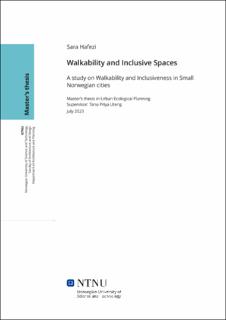| dc.description.abstract | Denne masteroppgaven utforsker gangvennlighet, inkluderende mobilitet og byrom i mindre norske byer med et mål om å forstå hvordan gangvennlighet kan skape inkluderende rom og fremme bærekraftig transport. Fokuset ligger på viktigheten av gangvennlighet i utformingen av inkluderende rom, rollen til ulike befolkningsgrupper i utformingen av inkluderende mobilitet, hvordan ulike befolkningsgrupper påvirker utformingen av inkluderende mobilitet, de ulike behovene for å gå i forskjellige sosiodemografiske grupper, forbedringspunkter i planleggingen av gangvennlighet i mindre byer og anvendelige metoder.
Litteraturstudiet tydeliggjør betydningen av gangvennlighet i byplanlegging og utforsker konseptet 15-minuttersbyer og skjæringspunktet mellom gangvennlighet og andre aspekter innen byplanlegging.
Med grunnlag i sosial praksisteori og retten til byen legger det teoretiske rammeverket vekt på å forstå de sosiale og fysiske aspektene som påvirker våre gåvaner og fremme rettferdig tilgang til urbane ressurser. Forskningsmetodikken kombinerer kvalitative og kvantitative metoder for å analysere gangvennlighet og dens forskjeller i ulike befolkningsgrupper.
Funnene fremhever viktigheten av gangvennlighet når man designer inkluderende rom, fremmer aktiv mobilitet og rettferdig tilgang til tjenester. De indikerer at kravene for å kunne gå varierer blant de sosiodemografiske gruppene med tanke på faktorer som infrastruktur, fasiliteter og attraktivitet. De kvantitative analysene viste at kjønn, alder og hvor lenge man har bodd i byen påvirker innbyggernes oppfatning av gangvennligheten i sentrum. I tillegg påvirket kjønn, alder, utdanningsnivå og førerkort befolkningens gåvaner i de ulike årstidene betydelig. Forbedringspunkter inkluderer tydelige målsetninger, interessentengasjement og tilpasning til urbane bærekraftsmål.
Resultatene impliserer behovet for utfyllende vurderingsrammer som tar hensyn til demografiske endringer og befolkningsbehov i bærekraftig transportplanlegging samt integrering av kvalitative og kvantitative metoder. Forskningen bidrar til diskusjonen om gangvennlighet og gir anbefalinger for å skape gangbare og inkluderende byer.
Nøkkelord: Gangvennlighet, inkluderende mobilitet, små norske byer, sosial praksisteori, retten til byen, 15-minuttersbyer. | |
| dc.description.abstract | This thesis explores walkability, inclusive mobility, and urban spaces in small Norwegian cities, aiming to understand how walkability can create inclusive spaces and promote sustainable transportation. It focuses on the importance of walkability in designing inclusive spaces, the role of different population groups in shaping inclusive mobility, the varying needs for walking among sociodemographic groups, areas for improvement in walkability planning in small cities, and applicable methodologies.
The literature review emphasizes the significance of walkability in urban planning and explores the concept of the 15-minute city and the intersectionality of walkability with other urban planning concepts.
Grounded in Social Practice Theory and the right to the city, the theoretical framework emphasizes understanding the social and material aspects influencing walking practices and promoting equitable access to urban resources. The research methodology combines qualitative and quantitative methods to analyze walkability and its relationship with different population groups.
Findings highlight the importance of walkability in designing inclusive spaces, promoting active mobility, and equitable access to services. The findings indicated that the needs regarding walking vary among sociodemographic groups, considering factors like infrastructure, amenities, and attractiveness. Furthermore, the quantitative analyses exhibited that gender, age, and the time one has lived in a city, affected the inhabitants' perception of the city center's walkability. Moreover, gender, age, education level, and holding a driver's license had significant effects on the population's walking behavior during different seasons. Areas for improvement include goal-setting, stakeholder engagement, and alignment with urban sustainability objectives.
Implications include the need for comprehensive assessment frameworks, considering demographic shifts and population needs in sustainable transportation planning, and integrating qualitative and quantitative methods. The research contributes to the discussion on walkability and provides recommendations for creating walkable and inclusive cities.
Keywords: Walkability, Inclusive mobility, Small Norwegian cities, Social Practice Theory, Right to the city, 15-minute city. | |
